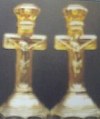Carnival Glass 101 | home Quick Reference to Carnival Glass Patterns on This Site
Imperial Helios - Part 1
Imperial Helios - Part 1
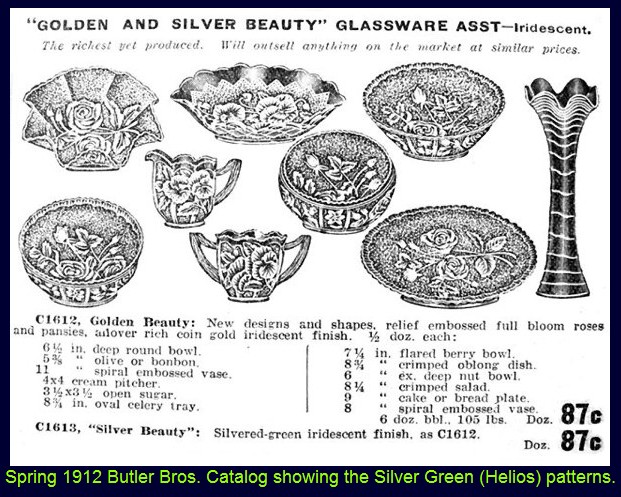
Reading the small print within this Butler Bros. ad reveals that two finishes were available in this specialized color! “Coin Gold or Silvery”. That is accuracy in advertising in its finest terms, for every piece in this helios category can be defined as such. We will go another step beyond that description to note that there are also “degrees” of green in the base glass, just as there were in the other color mixes found in iridized glass, so to separate the terms “emerald green” and “green” from “helios” requires a personal ascertainment of color refinement.
In other words, it can be a stretch to call it green in hopes of making more money from the piece, or allowing your soul-search to arrive and settle for helios in its purest form.
Further discretion is required when calling a piece “emerald green.” All three `greens' are determined by the “base glass color” and not by the iridescent spray. Just as “natural emerald gemstones” offer their appearance, so we judge that color in the glass. Emerald green examples usually offer bright, blues, greens and reds in a multicolor hue.
Green can be somewhat darker, or may even display some streaks of pigment which were not completely mixed into the batch of glass! Arriving at helios: it can be a more watery, light shade of green with either the gold or silvery overlay.
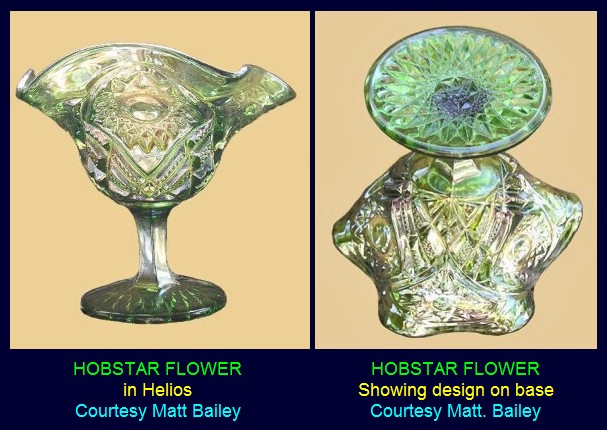
HOBSTAR FLOWER: Although some references state that in years past, the design had been attributed to Northwood, we believe that anyone who has ever owned a purple example, would discredit that in a flash! They are unmistakably Imperial purple!
Helios examples will bear out the same conclusion, of course. Imperial produced this intended color as no other manufacturer could or did. The radium type iridescence simply screams Imperial. Found only in this 5”-5 1/2” tall, stemmed, ruffled compote shape, with marigold the only other confirmed color known, it is a supreme example of helios! Here, as in some other cases, “emerald” green has been reported. That particular coloration must be accented by strong blue highlights, tinged with red, and we have not seen any with that attribute to date. Marigold is more difficult to locate than purple, and helios compotes can be considered quite rare indeed!
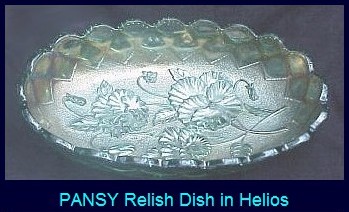
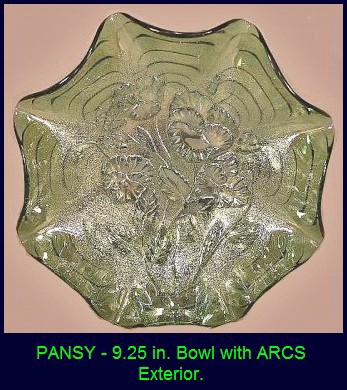
PANSY: This oval pickle dish is a perfect example of the “silvery” finish. Available in marigold, purple, clambroth, amber, and cobalt blue in the vintage glass.
Ruffled bowls in the 8”- 9 ½” size are found in marigold, purple, lavender, smoke, amber, and aqua additionally. These 9 ½” low-ruffled bowls are found in the same colors, excepting aqua.
The oval pickle dish was reproduced during the 60s and 70s in colors of marigold, smoke, helios, white, pink, red and ice blue. They were all marked with the IG trademark.
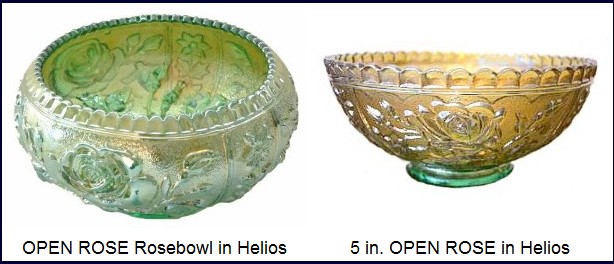
OPEN ROSE: Additional colors found in this collar base berry bowl, 7 ½”-9” size: marigold, purple, amber, lavender. Rosebowl shape is found in marigold, purple, amber and clambroth.
The Open Rose pattern was reproduced during the 60s and 70s in a wide variety of shapes, including a chop plate in the 11” size. There were no chop plates in the older glass. Colors to be aware of: marigold, smoke, helios, purple, amber, {meadow green}, white, red and pink. All items were marked with either IG, LIG, or ALIG logos.
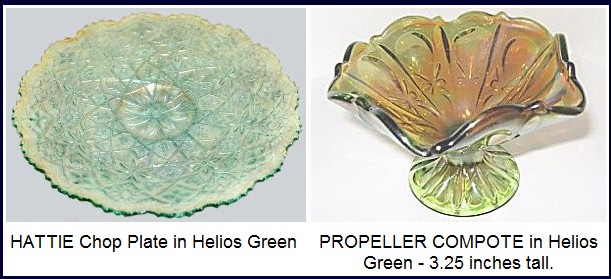
HATTIE: Round, deep bowls, 8” in diameter, rose bowls created from the same mold, and 10”-11” chop plates in marigold, purple, helios, amber are to be found with some effort. The chop plates are rare in any color, with marigold plates found more often than helios. Amber is a very rare color in the chop plates, with purple being the top ranking rarity. While there may be some clambroth examples out there; quite honestly, during our more than 30 years of scouring over every auction brochure from our crew of carnival glass auctioneers, along with travel and search on our own, we have yet to be presented with an example in that color.
PROPELLER: Crystal compotes in this pattern appeared in the 1905 Butler Bros. wholesale catalog. Only three shapes are known in the iridized versions. This small compote standing slightly under 3” tall, with a diameter of some 5” is plentiful in marigold. Helios and green examples seem to be rather scarce, with purple and smoke compotes considered extremely rare.
The larger 8”-9” compote is known only in marigold, as is the 7 ½” stemmed vase in this pattern. These ruffled vases were formed from the larger compote mold and along with the larger compote, are extremely rare.
Dean & Diane Fry - 5/07
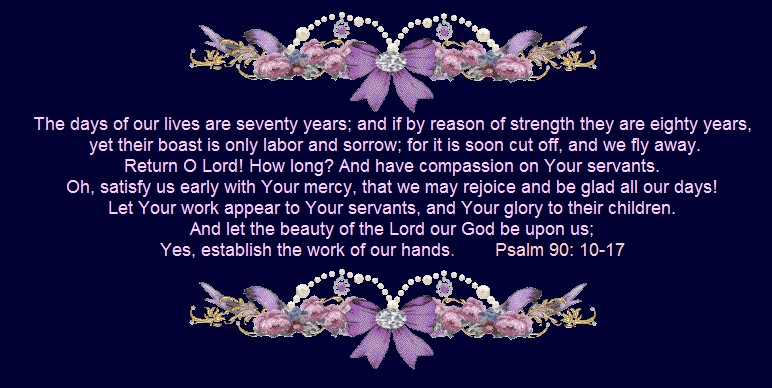
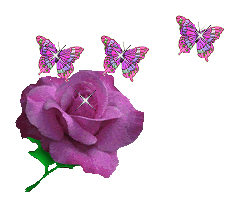
Should you care to contact the Frys, their email address is:
Search Our Sites
back to Carnival Glass 101
Our other sites you may enjoy:
Everything you EVER wanted to know about Indiana Glass
Great Reference for Newer Carnival Glass.
Complete Glassware Catalogs Available to Download
Questions? Comments? Suggestions? Broken Links? Corrections?
Your Friendly Webmaster is here to help!
